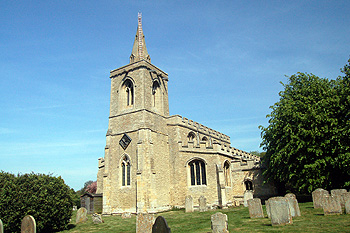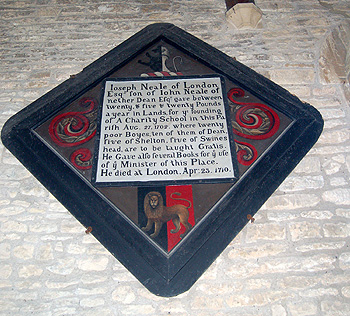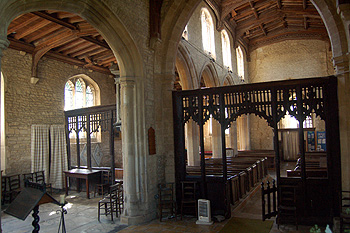
The church from the south-west May 2011
There was a school in Dean at least as early as 1637. In March that year a man named Rev. Ralph Josselin (1616-1683) went to Dean to be schoolmaster, staying until October 1639 [CRT130Dean2].
Volume 81 published by Bedfordshire Historical Records Society (2002) is a series of episcopal visitations undertaken in the first twenty years of the 18th century, edited by former County Archivist Patricia Bell. At each visitation a list of questions was sent out in advance, one of which enquired about the provision of schools in each parish. In 1706 the return stated: “There is a Charitie School for 20 poor Boys whose Parents are not worth £100. Ten of them of Dean, Five of Shelton in this County, and five of Swineshead in the County of Huntingdon. It was founded by Joseph Neale of London Esquire A. D. 1702. The Endowment is of certain lands in the county of Huntingdon now let for about £24 per Annum”. These lands were in Great and Little Catworth and comprised 71 acres, 3 roods, 9 poles and were originally worth £2,501/10/- [CRT130Dean1].

Joseph Neal charity board May 2011
A board in the north chapel (now the vestry) of the church in Upper Dean reads as follows: “Joseph Neale of London Esqr son of John Neale of nether Dean Esqr gave between twenty & five & twenty Pounds a year in lands for ye foudning of A Charity School in this Parish Aug 27, 1702, where twenty poor Boyes, ten of them of Dean, five of Shelton, five of Swineshead, are to be taught Gratis. Ho Gave also several Books for ye use of ye Minister of this Place. He died at London Apr 23, 1710”.
A terrier of church lands in Dean [ABE2 folio 301d] mentions a schoolmaster in about 1708. His salary was £20 to £25 and he was Peter Boundy, the vicar.
In 1709 the return stated: “No Public or Charity Schole [sic], save that before mentioned”. In 1717 the vicar wrote: “There is a Charity school, founded by Joseph Neal Esquire, where 20 boys, 10 of dean, 5 of Swineshead, 5 of Shelton, are taught the English tongue, and Instructed in the principles of the Christian Relligion [sic], by me Peter Boundy”. In 1720 he wrote: “There is a Charity School of about twenty one pounds per annum, Founded in 1702 by Joseph Neal of St. Andrew’s Holburn in London Esqr., for the Teaching of twenty poor boys, and I Peter Boundy am appointed Schoolmaster, by the said Joseph Neal”.

The nave and south aisle seen from the chancel May 2011 - the south chapel is the area stretching to the screen on the left hand side of the shot
In 1748 the Bishop of Lincoln licensed Israel Howard to be schoolmaster at Dean [WG1109]. Artist Thomas Fisher used some notes about Dean taken in 1781 to make drawings. The notes state [Fisher Microfilm Vol. II page 400] that the south chancel chapel [see the photograph above] was until lately used as the school room for Joseph Neal’s Charity School. The notes in full read as follows: “The South Chancel was till lately a school room for ye Charity Children of Neales foundation. Joseph Neale Esq anno 172, founded a Charity School to be under ye direction of certain Feoffees & Trustees. The Indentures or Foundation Charter, us’d to be annually & publickly read on Tuesday in Whitsun Week; but is now lost or secreted. It contain’s among others the following particulars. The Rectors of Tilbrook & Swineshead in Hunts for ye time being to be perpetual visitors. The master to be ye Curate of Dean if ye Trustees shall approve of him. A Sermon to be preachd on Whit Tuesday: 10 Southill to be allowed ye preacher. The visitors to make notice every Whit Tuesday of the Masters behaviour & the Boys Improvement. The Number of Boys 20. Ten out of Dean, 5 from Shelton & 5 from Swineshead. Their Parents not to be worth £100. If there be not ye numbers specified in either of the Parishes, then the number 20 to be made up out of either of ye other two. The Visitors are to acquaint ye Trustees how ye School is either managed or mismanaged. The master to keep a book of all ye names of his Scholars & ye examination of them to be in ye presence of the Trustees. The Boys are to be taught ye Catechism & English, Writing & Arethmetick. The Stipend arises from Lands lying in ye parishes of Spaldwick & Catworth in Huntingdonshire which are about £20 per annum”.
![Brook End and Pear Tree Cottage in 1933 [X504/1]](/CommunityHistories/UpperDean/UpperDeanImages/Pear Tree Cottage in 1933 [X504-1].jpg)
Brook End and Pear Tree Cottage in 1933 [X504/1]
By 1829 the school was held in a cottage in the village where it remained until at least 1866 and probably until the new school was built in 1876. It seems likely that the school moved here when it left the church shortly before 1781.The school house may have been today’s Pear Tree Cottage or just possibly Brook End as these two buildings are shown in a photograph album of 1933 and a more modern hand has annotated the photograph: “Peartree Cottage 17th cent once the Joseph Neale Charity School”. No evidence for this assertion is given.

Pear Tree Cottage May 2011
In 1818 a Select Committee was established to enquire into educational provision for the poor. This was no doubt prompted, in part, by the recent foundation of two societies promoting education and specifically the building of schools. The Society for Promoting the Lancasterian System for the Education of the Poor was established in 1808 promoting schools run along the lines pioneered by Joseph Lancaster, who had himself copied those of Dr. Andrew Bell, in which older children taught their younger fellows. The Society was renamed the British and Foreign School Society in 1814,. It was supported by a number of prominent nonconformists, Lancaster himself was a Quaker, and sought to teach a non-sectarian curriculum. In answer to this perceived nonconformist takeover of local education the National Society was formed in 1811 to encourage the teaching of poor children along Anglican lines, including the catechism. The Select Committee sent a questionnaire to all parishes in the country asking for: particulars relating to endowments for the education of children; other educational institutions; observations of parish needs etc. The return for Dean noted the school for twenty children under Joseph Neal’s charity and stating that the salary of the master was £50 per annum arising from seventy acres of land at Little Catworth [Huntingdonshire]. The return stated: “the poor are desirous of educating their children”.
In 1829 A man named Setchell was schoolmaster. His salary was £30 per annum. He died in February 1842 [WG]. The Wade Gery archive notes an advertisement in the Cambridge Chronicle and Northampton Herald in 1842. The advertisement was for: “a schoolmaster to instruct 24 poor boys in reading, writing and arithmetic, at a salary of £35, with the privilege of taking scholars on his own account, for which Dean is well situate”. The successful candidate was H. Corby of Sharnbrook. School hours at the time were 9 a. m. to noon and 1.30 p. m. to 4 p. m. in summer, 3.30 p. m. in winter. Term began on 6th January [WG]
In the country generally the number of schools built continued to grow over the next fifteen years so that by 1833 the government agreed to supplement the work of the two societies, and local benefactors, by making £20,000 per annum available in grants to help build schools. It also prompted another questionnaire to be sent to each parish in England asking for details of local educational provision. The Dean return was as follows: “One Daily School, for the education of 20 poor boys; endowed in 1702 by J Neal, Esq. with a house, farm and 70 acres of land, situated in Great and Little Catworth, which produced £64 per annum. One Sunday School. At which are 55 males and 55 females, supported by subscriptions of the Wesleyan Methodists”. In those days a Sunday school was just that, a school which met on a Sunday, usually in the church or nonconformist chapel or other similar building, teaching more than the religious topics with which they are associated today.
The next national enquiry was in 1846/7 when the Church of England made an enquiry as to all its church schools. This was against the background of a new Whig government which championed secular education and the increasing importance of nonconformists, particularly Wesleyan Methodist, and Roman Catholics in providing schools. The return for Dean noted that 25 boys and 36 girls attended Sunday school and that a daily school taught 55 boys and 45 girls. It stated: “The schoolroom and house are both rented, and are both very bad. A schoolroom is much needed. A site has been promised, but the parishioners are now building a parsonage house, and the school has been allowed to fall into abeyance”.
The first Education Act was passed in 1870 (more correctly it was known as the Elementary Education Act). It was a milestone in the provision of education in Britain demonstrating central government's unequivocal support for education of all classes across the country. It also sought to secularise education by allowing the creation of School Boards. These were groups of representatives, elected by the local ratepayers and the Board had the powers to raise funds to form a local rate to support local education, build and run schools, pay the fees of the poorest children, make local school attendance compulsory between the ages of 5 and 13 and could even support local church schools, though in practice they replaced them, turning them into Board run schools (known as Board Schools). Naturally, and luckily for local historians, the Act required a questionnaire of local schools in 1870. The return for Dean stated that there was no efficient school and that a school for 81 boys and girls and 60 infants was required at Upper Dean.
H. Corby, appointed in 1842 was still the schoolmaster and by 1875, when he was 65, the school managers were considering retiring him with a pension of £20 per annum. In 1846 he had managed to get his salary increased to £65 per annum by taking on paying pupils. His official salary was £50 in 1858 and £46 in 1866 [WG].